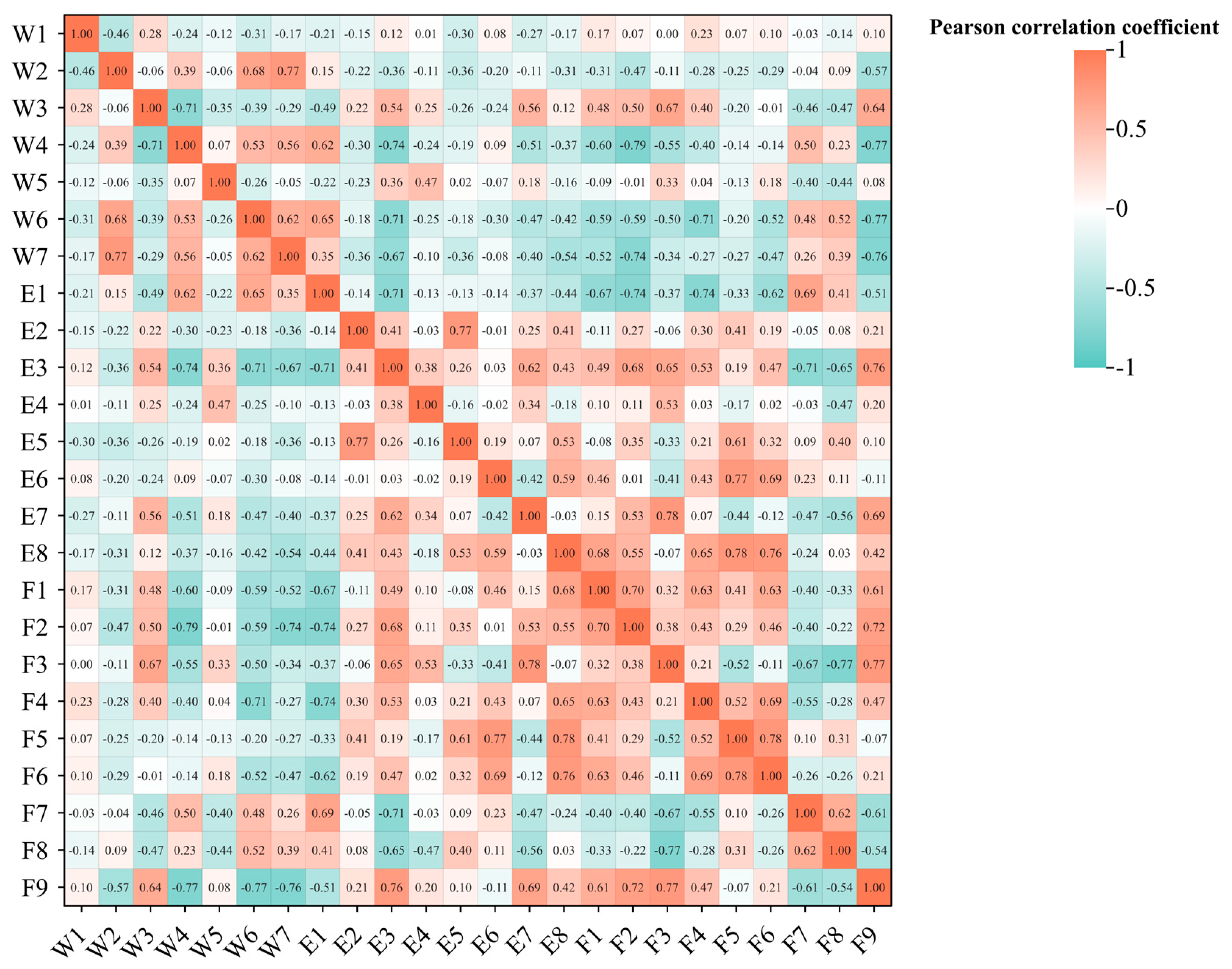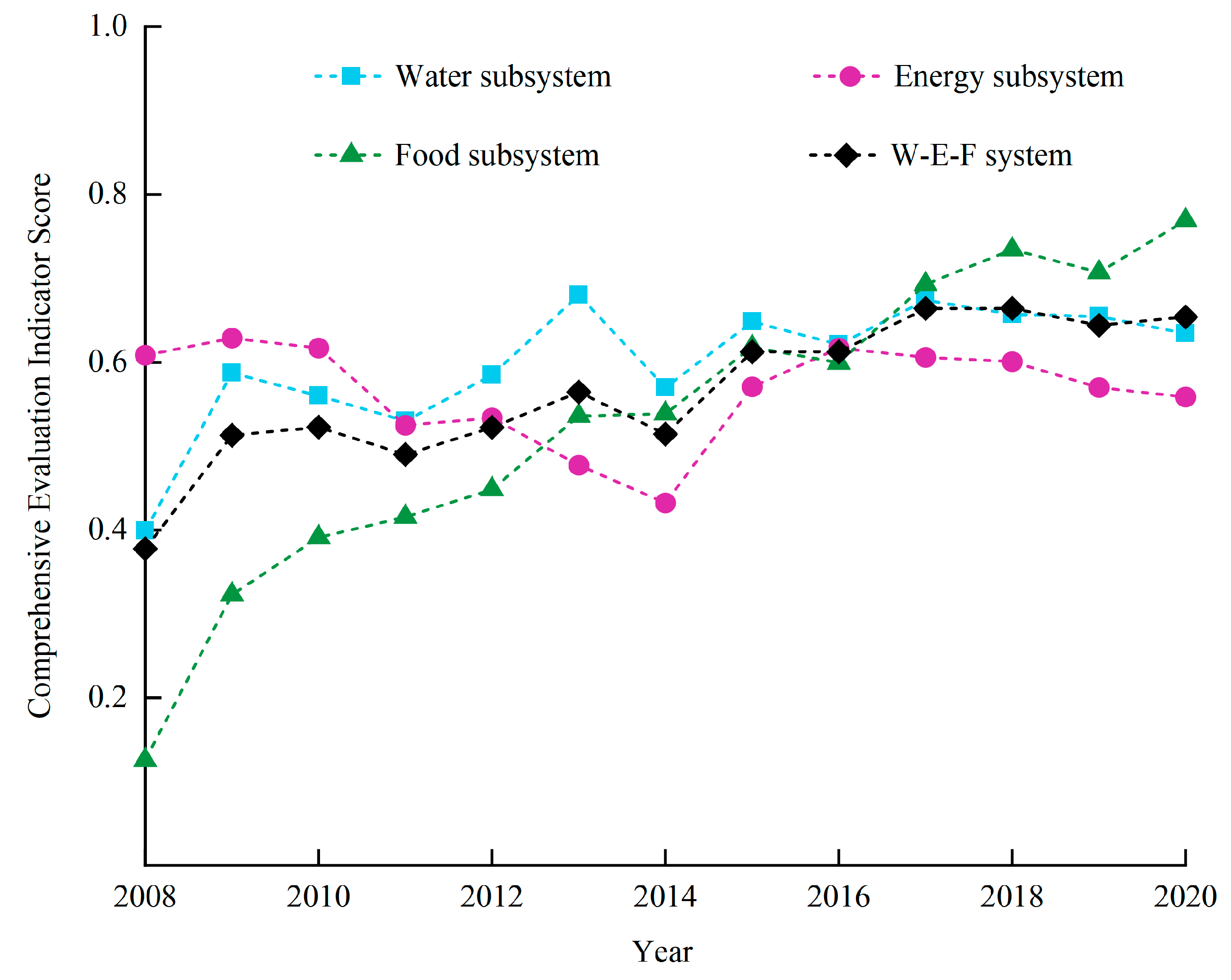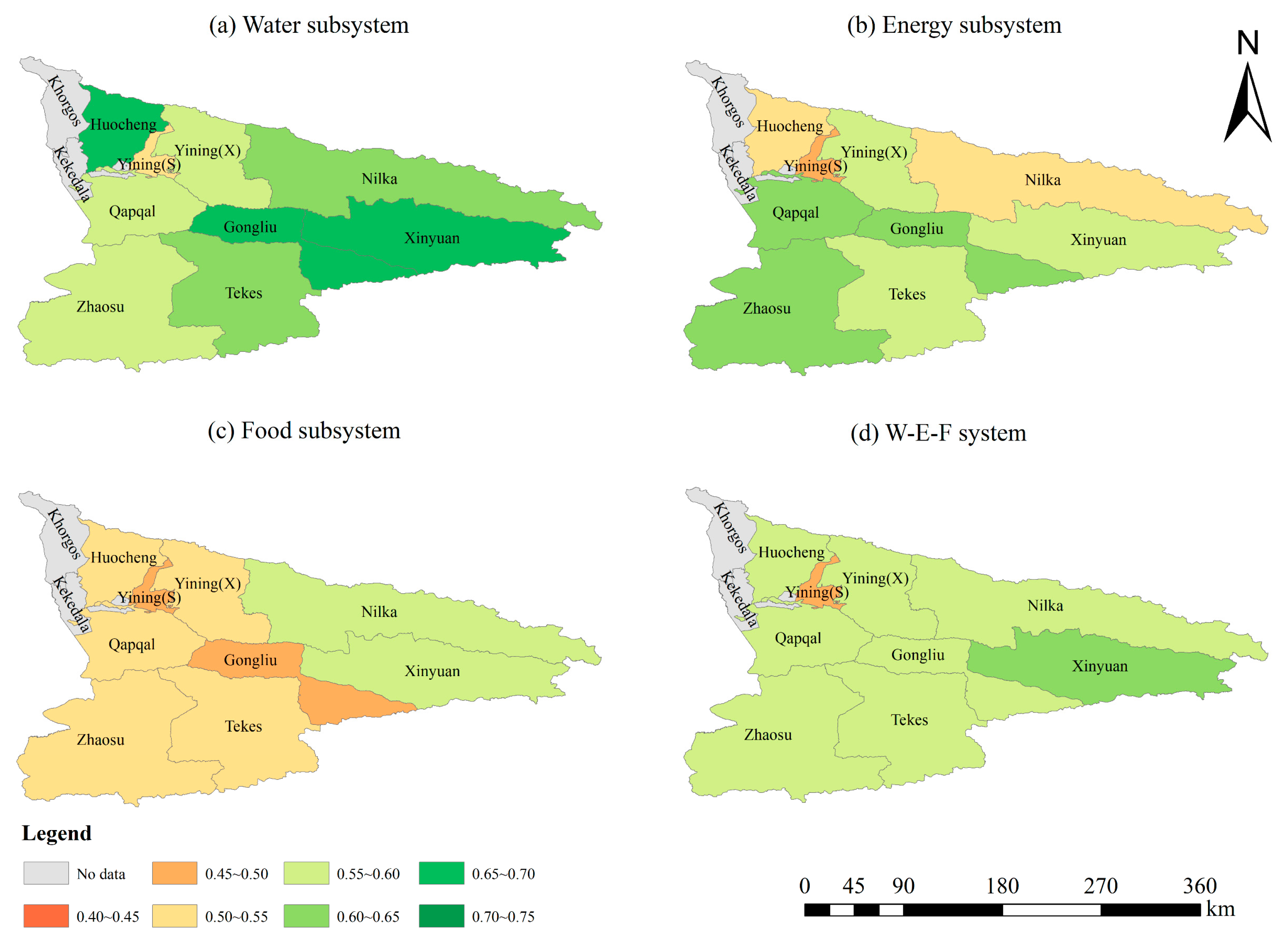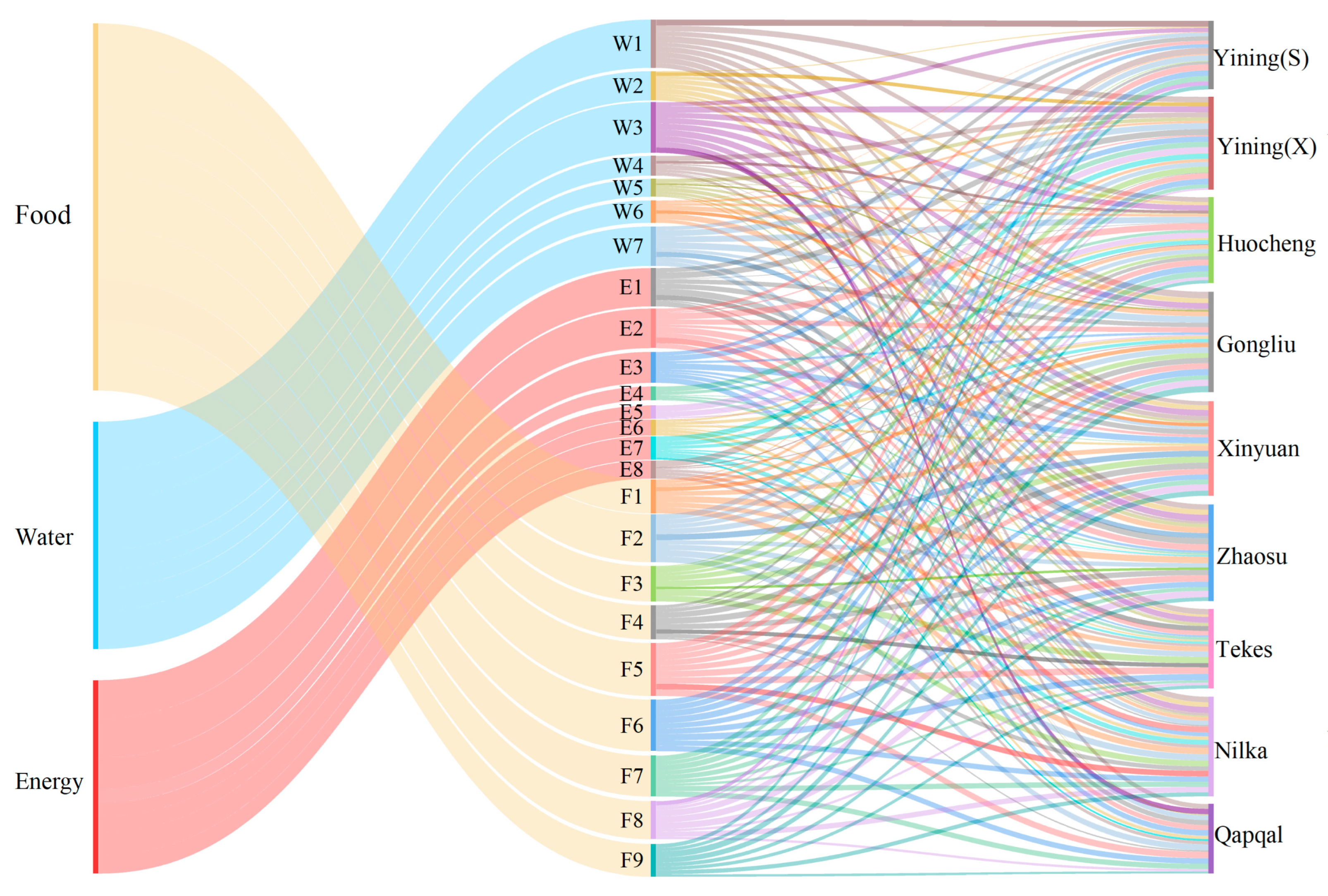Assessing the Coordination and Spatial Equilibrium of Water, Energy, and Food Systems for Regional Socio-Economic Growth in the Ili River Valley, China
Abstract
:1. Introduction
2. Materials and Methods
2.1. Overview of the Study Area
2.2. Methodology
2.2.1. Construction of Comprehensive Evaluation Indicator System of W-E-F System in Ili River Valley
2.2.2. Data Standardization and Weight Determination
- Data standardization
- 1.
- Positive indicators:
- 2.
- Negative indicators:where x′ij is the standardized data value; xij is the original data value; the variables xij(max) and xij(min) denote the maximum and minimum values of the indicators, respectively.
- Determination of indicator weights
2.2.3. Calculation of the Comprehensive Evaluation Indicators
2.2.4. Coupling Coordination Model
- 1.
- 2.
- Coordination degree calculation formula:where T represents the degree of coordination, and α, β, and γ represent the weights of the water, energy, and food subsystems, respectively. Referring to the results of previous studies [42,43], combined with the actual situation of the region, this study considers that the statuses of the water resource, energy, and food subsystems in the study area are equally significant, each assigned a weight of 1/3;
- 3.
2.2.5. Spatial Equilibrium Model
2.3. Data Sources
3. Results
3.1. Changes in the Comprehensive Evaluation Indicators of the W-E-F System in the Ili River Valley
3.1.1. Analysis of Time Series Changes in the Comprehensive Evaluation Indicators
3.1.2. Analysis of Spatial Changes in the Comprehensive Evaluation Indicator
3.2. Analysis of the Coupling Degree of the W-E-F System and the Changes in the Coupling Coordination Degree in the Ili River Valley
3.2.1. Analysis of the Changes in the Coupling Degree of the W-E-F System in the Ili River Valley
3.2.2. Changes in the Coupling Coordination Degree of W-E-F System in the Ili River Valley
3.3. Analysis of the Spatial Equilibrium Degree of the W-E-F System in Ili River Valley
4. Discussion
4.1. Analysis of Factors Affecting the Coordinated Development of the Coupled W-E-F System in the Ili River Valley
4.2. Adaptations and Limitations of the Research Methodology
5. Conclusions
- From 2008 to 2020, the comprehensive evaluation indicators of the W-E-F system in the Ili River Valley showed an overall upward trend, rising from 0.378 to 0.674, with a mean yearly growth rate of 5.24%, indicating that the comprehensive development level of the system was moving in a positive direction, which is closely related to the rapid development of the food subsystem. Among the subsystems, the comprehensive evaluation indicator of the water subsystem showed a fluctuating upward trend, with a mean yearly growth rate of 5.45%, though it experienced significant fluctuations during the study period, particularly slowing after 2014. The over-representation of agricultural water use was a key factor affecting the development of the water subsystem. The comprehensive evaluation indicator of the energy subsystem exhibited fewer fluctuations, with a mean yearly growth rate of −0.30%, showing a slight downward trend, indicating constraints on the development of energy subsystems. Agricultural surface pollution and industrial waste pollution are the primary factors limiting its development. The food subsystem, benefiting from significant government attention, developed rapidly, with its comprehensive evaluation indicator showing a significant upward trend and a mean yearly growth rate of 20.85%, which shows that the region is actively promoting food production capacity enhancement initiatives;
- The coupling degree of the W-E-F system in the Ili River Valley from 2008 to 2020 showed a generally smooth development trend, with a high overall development level. The average value ranged between 0.7 and 1.0, indicating a state of coordinated coupling. This indicates that there is a clear interaction and mutual constraints between the subsystems. It also indicates that the system will be more fragile and that dynamic changes within any one of the subsystems will have a significant impact on the development of the other two subsystems. Therefore, sustainable regional resource management can only be achieved if the synchronized development of the three resources is maintained. The coupling coordination degree transitioned through stages of near coordination, preliminary coordination, good coordination, and medium coordination, with an average annual growth rate of 3.65%. Counties and cities showed a tendency to evolve towards higher levels of coupling coordination, with the development types categorized into the “stable-rising” and “fluctuating-rising” types. There remains substantial potential for further development of the regional W-E-F system’s coupling coordination;
- From 2008 to 2020, within the W-E-F system of the Ili River Valley, the food subsystem exhibited the largest spatial equilibrium and the smallest spatial disparities, while the energy subsystem demonstrated the smallest spatial equilibrium and the largest spatial disparities. The water subsystem’s spatial equilibrium was intermediate between the two. The spatial equilibrium differences across indicators were significant, with the spatial equilibrium in the Proportion of food crop-planted area reaching 0.89, while the spatial equilibrium of Industrial wastewater emissions was the smallest, at only 0.18. This indicates that the food subsystem across the counties and cities in the Ili River Valley followed a consistently positive development trend, whereas the development of the energy subsystem exhibited strong geographic differentiation, continuously affecting the rational allocation and use of regional resources, and thereby influencing the overall stability and sustainable development of the W-E-F system.
Author Contributions
Funding
Data Availability Statement
Conflicts of Interest
References
- Raya-Tapia, A.Y.; Cansino-Loeza, B.; Sánchez-Zarco, X.G.; Ramírez-Márquez, C.; Martín, M.; Ponce-Ortega, J.M. A spatial and temporal assessment of resource security in the water, energy, food and waste nexus in Spain. Sustain. Prod. Consum. 2023, 39, 109–122. [Google Scholar] [CrossRef]
- Fu, N.; Liu, D.; Liu, H.; Pan, B.; Ming, G.; Huang, Q. Evaluation of the Coupled Coordination of the Water–Energy–Food–Ecology System Based on the Sustainable Development Goals in the Upper Han River of China. Agron. J. 2024, 14, 706. [Google Scholar] [CrossRef]
- Wang, Y.; Song, J.; Sun, H. Coupling interactions and spatial equilibrium analysis of water-energy-food in the Yellow River Basin, China. Sustain. Cities Soc. 2023, 88, 104293. [Google Scholar] [CrossRef]
- Prokisch, J.; Sári, D.; Muthu, A.; Nagy, A.; El-Ramady, H.; Abdalla, N.; Dobránszki, J. Biotechnology of Nanofiber in Water, Energy, and Food Sectors. Agron. J. 2023, 13, 2734. [Google Scholar] [CrossRef]
- Chen, R.; Wang, Z.; Dhital, Y.P.; Zhang, X. A comparative evaluation of soil preferential flow of mulched drip irrigation cotton field in Xinjiang based on dyed image variability versus fractal characteristic parameter. Agric. Water Manag. 2022, 269, 107722. [Google Scholar] [CrossRef]
- Ma, Z.; Liu, J.; Zhang, J.; Yin, F.; Guo, L.; Wen, Y.; Song, L.; Zhu, Y.; Liang, Y.; Wang, Z. Ultra-wide film mulching with moderate irrigation water salinity enhances cotton growth under drip irrigation in Xinjiang, China. Field Crops Res. 2024, 315, 109485. [Google Scholar] [CrossRef]
- Li, L.; Li, J.; Yu, R. Characteristics of summer regional rainfall events over Ili River Valley in Northwest China. Atmos. Res. 2020, 243, 104996. [Google Scholar] [CrossRef]
- Gao, Y.; Lu, C.-C.; Wu, W.-S. Water-energy-food (WEF) nexus efficiency of dynamic slack-based measure in 31 provinces and regions in China. J. Clean. Prod. 2024, 460, 142433. [Google Scholar] [CrossRef]
- Mroue, A.M.; Mohtar, R.H.; Pistikopoulos, E.N.; Holtzapple, M.T. Energy Portfolio Assessment Tool (EPAT): Sustainable energy planning using the WEF nexus approach—Texas case. Sci. Total Environ. 2019, 648, 1649–1664. [Google Scholar] [CrossRef]
- Zheng, D.; An, Z.; Yan, C.; Wu, R. Spatial-temporal characteristics and influencing factors of food production efficiency based on WEF nexus in China. J. Clean. Prod. 2022, 330, 129921. [Google Scholar] [CrossRef]
- Wu, K.; Wen, H.; Wang, T.; Chen, M.; You, L.; Liu, Y.; Zhang, J.; Li, Y.; Huang, G. Water rights trading planning and its application in water resources management: A water-ecology-food nexus perspective. Environ. Res. 2024, 249, 118377. [Google Scholar] [CrossRef]
- Huan, S.; Liu, X. Network modeling and stability improvement of the water-energy-fertilizer-food nexus flows based on global agricultural trade. Sustain. Prod. Consum. 2023, 39, 480–494. [Google Scholar] [CrossRef]
- Zeng, Y.; Liu, D.; Guo, S.; Xiong, L.; Liu, P.; Chen, J.; Yin, J.; Wu, Z.; Zhou, W. Assessing the effects of water resources allocation on the uncertainty propagation in the water–energy–food–society (WEFS) nexus. Agric. Water Manag. 2023, 282, 108279. [Google Scholar] [CrossRef]
- Terrapon-Pfaff, J.; Ortiz, W.; Dienst, C.; Gröne, M.-C. Energising the WEF nexus to enhance sustainable development at local level. J. Environ. Manag. 2018, 223, 409–416. [Google Scholar] [CrossRef]
- Mondal, K.; Chatterjee, C.; Singh, R. Examining the coupling and coordination of water-energy-food nexus at a sub-national scale in India—Insights from the perspective of Sustainable Development Goals. Sustain. Prod. Consum. 2023, 43, 140–154. [Google Scholar] [CrossRef]
- Javan, K.; Altaee, A.; BaniHashemi, S.; Darestani, M.; Zhou, J.; Pignatta, G. A review of interconnected challenges in the water–energy–food nexus: Urban pollution perspective towards sustainable development. Sci. Total Environ. 2024, 912, 169319. [Google Scholar] [CrossRef]
- Lv, Y.; Li, Y.; Zhang, Z.; Luo, S.; Feng, X.; Chen, X. Spatio-temporal evolution pattern and obstacle factors of water-energy-food nexus coupling coordination in the Yangtze River economic belt. J. Clean. Prod. 2024, 444, 141229. [Google Scholar] [CrossRef]
- Sui, G.; Wang, H.; Cai, S.; Cui, W. Coupling coordination analysis of resources, economy, and ecology in the Yellow River Basin. Ecol. Indic. 2023, 156, 111133. [Google Scholar] [CrossRef]
- Wang, Y.; Xie, Y.; Qi, L.; He, Y.; Bo, H. Synergies evaluation and influencing factors analysis of the water–energy–food nexus from symbiosis perspective: A case study in the Beijing–Tianjin–Hebei region. Sci. Total Environ. 2022, 818, 151731. [Google Scholar] [CrossRef]
- An, H.; Li, X.; Huang, J.; Wu, H. Synergistic evolution of water-energy-food system resilience and efficiency in urban agglomerations. J. Environ. Manag. 2024, 355, 120371. [Google Scholar] [CrossRef]
- Xu, Y.; Li, J.; Li, H.; Yang, S.; Jiang, Q.; Sui, P.; Gao, W.; Cui, J.; Chen, Y. The water-food-energy nexus evaluation and optimization of cropping system in the North China Plain: A case of county scale. J. Clean. Prod. 2024, 443, 141200. [Google Scholar] [CrossRef]
- Zhang, Y.; Wu, Y.; Lu, Z.; Li, L.; Wang, P. Coupling efficiency and spatial dynamic evolution of urban water–energy–food in China–A case of evidence from 94 cities. Heliyon 2024, 10, e33187. [Google Scholar] [CrossRef]
- Elena Villalba-Pastrana, M.; Patricia Güereca, L. Environmental impacts of water, food and energy nexus in Mexico City from an Organizational Life Cycle approach. City Environ. Interact. 2024, 22, 100143. [Google Scholar] [CrossRef]
- ElZein, Z.; Milad, N.A.; Mohamed, A.S.; Mahmoud, N.; Abdo, N.; Abdel-Ghafar, H.M. Sustainable development on the basis of the WEF nexus in arid coastal areas for climate change mitigation: Case study of Rabia community in Matrouh, Egypt. Energy Nexus 2024, 14, 100299. [Google Scholar] [CrossRef]
- Romero-Lankao, P.; Bruns, A.; Wiegleb, V. From risk to WEF security in the city: The influence of interdependent infrastructural systems. Environ. Sci. Policy 2018, 90, 213–222. [Google Scholar] [CrossRef]
- John, T.W.; Sušnik, J.; Masia, S.; Jewitt, G. Towards realization of nexus-doing at the grassroots level: Water-energy-food governance assessment in the Songwe River Basin (Tanzania and Malawi). Environ. Sci. Policy 2023, 150, 103596. [Google Scholar] [CrossRef]
- Ngarava, S. Implications of land restitution as a Transformative Social Policy for Water-Energy-Food (WEF) insecurity in Magareng Local Municipality, South Africa. Land Use Policy 2023, 133, 106878. [Google Scholar] [CrossRef]
- Wicaksono, A.; Kang, D. Nationwide simulation of water, energy, and food nexus: Case study in South Korea and Indonesia. J. Hydro-Environ. Res. 2019, 22, 70–87. [Google Scholar] [CrossRef]
- Lee, S.-H.; Assi, A.T.; Mohtar, R.H.; Hamane, M.; Yoon, P.R.; Yoo, S.-H. Development of WEF-P Nexus based on product-supply chain: A case study of phosphorous fertilizer industry in Morocco. Sci. Total Environ. 2023, 857, 159520. [Google Scholar] [CrossRef]
- Wang, Q.; Li, S.; He, G.; Li, R.; Wang, X. Evaluating sustainability of water-energy-food (WEF) nexus using an improved matter-element extension model: A case study of China. J. Clean. Prod. 2018, 202, 1097–1106. [Google Scholar] [CrossRef]
- Masia, S.; Sušnik, J.; Jewitt, G.; Kiala, Z.; Mabhaudhi, T. Chapter 6—Transboundary WEF nexus analysis: A case study of the Songwe River Basin. In Water-Energy-Food Nexus Narratives and Resource Securities; Mabhaudhi, T., Senzanje, A., Modi, A., Jewitt, G., Massawe, F., Eds.; Elsevier: Amsterdam, The Netherlands, 2022; pp. 91–109. [Google Scholar] [CrossRef]
- Suda, A.O.; Sušnik, J.; Masia, S.; Jewitt, G. Policy coherence assessment of water, energy, and food resources policies in the Tana River Basin, Kenya. Environ. Sci. Policy 2024, 159, 103816. [Google Scholar] [CrossRef]
- Almulla, Y.; Ramirez, C.; Joyce, B.; Huber-Lee, A.; Fuso-Nerini, F. From participatory process to robust decision-making: An Agriculture-water-energy nexus analysis for the Souss-Massa basin in Morocco. Energy Sustain. Dev. 2022, 70, 314–338. [Google Scholar] [CrossRef]
- Wang, S.; Yang, J.; Wang, A.; Liu, T.; Du, S.; Liang, S. Coordinated analysis and evaluation of water–energy–food coupling: A case study of the Yellow River basin in Shandong Province, China. Ecol. Indic. 2023, 148, 110138. [Google Scholar] [CrossRef]
- Huang, D.; Wen, F.; Li, G.; Wang, Y. Coupled development of the urban water-energy-food nexus: A systematic analysis of two megacities in China’s Beijing-Tianjin-Hebei area. J. Clean. Prod. 2023, 419, 138051. [Google Scholar] [CrossRef]
- Zhang, P.; Zhou, Y.; Xie, Y.; Wang, Y.; Yang, Z.; Cai, Y. Spatial transmission mechanism of the water, energy and food nexus risks for the Guangdong-Hong Kong-Macao region of China. J. Clean. Prod. 2023, 405, 136906. [Google Scholar] [CrossRef]
- Pu, A. Xinjiang Water-Energy-Food Nexus Safety Evaluation and Factor Analysis. Master’s Thesis, Northwest Agriculture and Forestry University, Yangling, China, 2020. [Google Scholar] [CrossRef]
- Li, G.; Huang, D.; Sun, C.; Li, Y. Developing interpretive structural modeling based on factor analysis for the water-energy-food nexus conundrum. Sci. Total Environ. 2019, 651, 309–322. [Google Scholar] [CrossRef]
- Lu, Q.; Yang, Y.; Li, B.; Li, Y.; Wang, D. Coupling Relationship and Influencing Factors of the Water–Energy–Cotton System in Tarim River Basin. Agron. J. 2022, 12, 2333. [Google Scholar] [CrossRef]
- Bai, S. Study on Coupling Coordination Evaluation of Water-Energy-Food System in the Yellow River Basin. Master’s Thesis, North China University of Water Resources and Electric Power, Zhengzhou, China, 2022. [Google Scholar] [CrossRef]
- Luo, W.; Jiang, Y.; Chen, Y.; Yu, Z. Coupling Coordination and Spatial-Temporal Evolution of Water-Land-Food Nexus: A Case Study of Hebei Province at a County-Level. Land 2023, 12, 595. [Google Scholar] [CrossRef]
- Zhao, Y.; Shi, H.; Miao, Q.; Yang, S.; Hu, Z.; Hou, C.; Yu, C.; Yan, Y. Analysis of Spatial and Temporal Variability and Coupling Relationship of Soil Water and Salt in Cultivated and Wasteland at Branch Canal Scale in the Hetao Irrigation District. Agron. J. 2023, 13, 2367. [Google Scholar] [CrossRef]
- Zhao, C.; Geng, R.; Chi, T.; Khiewngamdee, C.; Liu, J. Agricultural Technology Innovation and Food Security in China: An Empirical Study on Coupling Coordination and Its Influencing Factors. Agron. J. 2024, 14, 123. [Google Scholar] [CrossRef]
- Wang, H.; He, S. Research on Factor Coupling of Industrialization of Oil and Gas Scientific and Technological Achievements. Energies 2023, 16, 4445. [Google Scholar] [CrossRef]
- Chen, K.; Tian, G.; Tian, Z.; Ren, Y.; Liang, W. Evaluation of the Coupled and Coordinated Relationship between Agricultural Modernization and Regional Economic Development under the Rural Revitalization Strategy. Agron. J. 2022, 12, 990. [Google Scholar] [CrossRef]
- Wang, Y. Spatial-Temporal Evolution and Influencing Factors of Water-Energy-Food in Yellow River Basin for the Perspective of Spatial Equilibrium. Ph.D. Thesis, University of Chinese Academy of Sciences, Beijing, China, 2023. [Google Scholar]
- Fan, H.; Liu, Y.; Liu, Y.; Wang, W.; Feng, Y. Study on rational allocation of water resources based on spatial balance. J. Water Resour. Water Eng. 2022, 33, 61–67. [Google Scholar] [CrossRef]
- Ma, C. On the Problems of Water-saving Irrigation in Ili River Basin in Xinjiang. Energy Energy Conserv. 2016, 6, 119–120. [Google Scholar] [CrossRef]
- Wang, Y.; Pu, A.; Yan, X.; Sun, J. Comprehensive Evaluation of Water-Energy-Food Nexus Safety in Xinjiang. Trans. Chin. Soc. Agric. Mach. 2020, 51, 264–272. [Google Scholar] [CrossRef]
- Feng, M.; Chen, Y.; Jiao, L.; Duan, W. Research on the coupling and coordinated development of water-energy food system in Xinjiang during 2000–2019. J. Water Resour. Water Eng. 2022, 33, 77–84. [Google Scholar] [CrossRef]








| Target Layer | Standardized Layer | Indicator Layer | Unit | Nature of the Indicator | |
|---|---|---|---|---|---|
| Comprehensive evaluation indicator system for W-E-F | Water subsystem | Status of resources | Annual precipitation (W1) | 108 m3 | + |
| Water consumption per capita (W2) | m3/person | − | |||
| Proportion of water consumption in agriculture (W3) | % | − | |||
| Structure of consumption | Proportion of water consumption in industry (W4) | % | − | ||
| Proportion of water consumption for domestic purposes (W5) | % | − | |||
| Benefits of utilization | Water consumption per CNY 10,000 of GDP (W6) | m3/CNY · 104 | − | ||
| Water consumption per unit of food production (W7) | m3/t | − | |||
| Energy subsystem | Structure of energy | Diesel use in agriculture (E1) | t | − | |
| Gross power of agricultural machinery (E2) | kw | + | |||
| Electricity consumption (E3) | 104 kw | − | |||
| Electricity generation (E4) | 104 kw | + | |||
| Environmental security | Industrial wastewater emissions (E5) | 104 t | − | ||
| Industrial waste gas emissions (E6) | 108 m3ce | − | |||
| Solid waste emissions (E7) | 104 t | − | |||
| SO2 emissions (E8) | t | − | |||
| Food subsystem | Production security | Per capita food production (F1) | kg/person | + | |
| Per hectare food production (F2) | t/ha | + | |||
| Cultivated land area per capita (F3) | m2/person | + | |||
| Effective irrigated area (F4) | 103 ha | + | |||
| Proportion of food crop-planted area (F5) | % | + | |||
| Proportion of planting area of crops with high water consumption (F6) | % | − | |||
| Consumer security | Fertilizer load (F7) | t/ha | − | ||
| Natural population growth rate (F8) | % | − | |||
| Gross agricultural output (F9) | CNY · 104 | + | |||
| Coupling Degree | Type of Coupling | Descriptions |
|---|---|---|
| (0~0.3) | Low coupling | The interactions and dependencies between the subsystems are low and the coupling is loose, and the subsystems are relatively independent in function and behavior. |
| [0.3~0.5) | Moderate coupling | There is a degree of interdependence and interaction between the subsystems, with moderate coupling and more pronounced interactions, but still maintaining a degree of independence. |
| [0.5~0.7) | High coupling | The subsystems are interdependent and tightly coupled, and a high degree of synergy exists; changes or perturbations in one subsystem may be rapidly transmitted to other subsystems, leading to significant reactions or adjustments in the entire system. |
| [0.7~1.0) | Coordinated coupling | The coupling between the subsystems reaches the highest level, forming an inseparable whole, the system is more fragile, and a change in any subsystem will directly and immediately affect the operation and state of the whole system, which shows a very high degree of integrality and inseparability. |
| Coupling Coordination Degree | Level of Coordination | Degree of Coupling Coordination |
|---|---|---|
| 0 < D < 0.1 | 1 | Extreme unbalance |
| 0.1 ≤ D < 0.2 | 2 | Serious unbalance |
| 0.2 ≤ D < 0.3 | 3 | Moderate unbalance |
| 0.3 ≤ D < 0.4 | 4 | Mild unbalance |
| 0.4 ≤ D < 0.5 | 5 | Imminent unbalance |
| 0.5 ≤ D < 0.6 | 6 | Near coordination |
| 0.6 ≤ D < 0.7 | 7 | Primary coordination |
| 0.7 ≤ D < 0.8 | 8 | Moderate coordination |
| 0.8 ≤ D < 0.9 | 9 | Good coordination |
| 0.9 ≤ D < 1.0 | 10 | Extreme coordination |
| Serial Number | Spatial Equilibrium Degree | Spatial Equilibrium Level |
|---|---|---|
| 1 | 0 | Total disequilibrium |
| 2 | (0, 0.2) | Basic disequilibrium |
| 3 | [0.2, 0.4) | General disequilibrium |
| 4 | [0.4, 0.6) | Near disequilibrium |
| 5 | [0.6, 0.8) | General equilibrium |
| 6 | [0.8, 1.0) | Basic equilibrium |
| 7 | 1.0 | Total equilibrium |
Disclaimer/Publisher’s Note: The statements, opinions and data contained in all publications are solely those of the individual author(s) and contributor(s) and not of MDPI and/or the editor(s). MDPI and/or the editor(s) disclaim responsibility for any injury to people or property resulting from any ideas, methods, instructions or products referred to in the content. |
© 2024 by the authors. Licensee MDPI, Basel, Switzerland. This article is an open access article distributed under the terms and conditions of the Creative Commons Attribution (CC BY) license (https://creativecommons.org/licenses/by/4.0/).
Share and Cite
Qin, G.; Liu, J.; Lin, H.; Javed, T.; Gao, X.; Tang, Y.; Mu, X.; Guo, M.; Wang, Z. Assessing the Coordination and Spatial Equilibrium of Water, Energy, and Food Systems for Regional Socio-Economic Growth in the Ili River Valley, China. Agronomy 2024, 14, 2037. https://doi.org/10.3390/agronomy14092037
Qin G, Liu J, Lin H, Javed T, Gao X, Tang Y, Mu X, Guo M, Wang Z. Assessing the Coordination and Spatial Equilibrium of Water, Energy, and Food Systems for Regional Socio-Economic Growth in the Ili River Valley, China. Agronomy. 2024; 14(9):2037. https://doi.org/10.3390/agronomy14092037
Chicago/Turabian StyleQin, Guopeng, Jian Liu, Haixia Lin, Tehseen Javed, Xuehui Gao, Yupeng Tang, Xiaoguo Mu, Muchan Guo, and Zhenhua Wang. 2024. "Assessing the Coordination and Spatial Equilibrium of Water, Energy, and Food Systems for Regional Socio-Economic Growth in the Ili River Valley, China" Agronomy 14, no. 9: 2037. https://doi.org/10.3390/agronomy14092037







